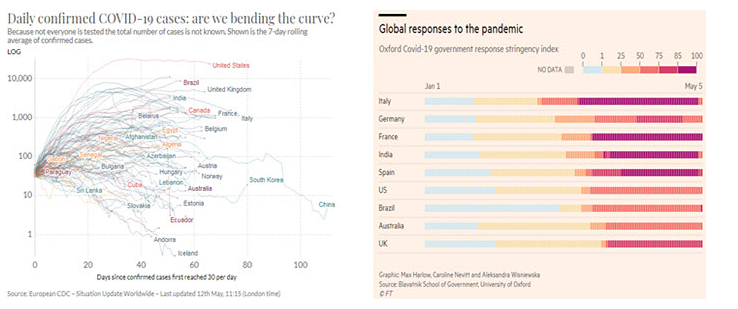I loved high school geometry. Shapes had intrigued me since I was very little, and the notion that you could express their properties mathematically appealed to my quantitative nature. I also enjoyed the logic in the Euclidean system of proofs, which build from simple truths to more complicated ones.
In geometry, the shortest distance between two points is a straight line. In economics, there are no straight lines: everything is a curve. The curves are difficult to draw, and they shift frequently. Thousands of curves describe an economy, and these have to be added and reconciled to find equilibrium. Truth in economics is not easily proven.
As we look ahead to a post-pandemic equilibrium, four curves will describe the arc of economic recovery. Movement along these frontiers will determine how fast we arrive at a new normal.
The first curve describes the progress of the pandemic itself. At the outset of an outbreak, cases grow exponentially; preventative measures slow this growth rate and “bend” the contagion curve. This calculus has been particularly important with COVID-19, given constraints within health care systems around the world.

Once the medical statistics improve, the second curve will be traced by public health policy. How soon will officials allow more freedom of movement, and what lingering restrictions will they require to ensure adequate safety? The last thing that anyone wants is a relapse, which would require the reinstatement and/or reinforcement of closure orders. Such a retreat (which we have already seen in several Asian countries) would be damaging both commercially and psychologically.
Societies do not have to wait until new cases fall to zero before reopening. But the risk of infection has to be brought under firm control. That risk informs decisions by economic actors that will determine the rate of commercial recovery.
A number of countries (and regions within countries) have begun the process of reopening. Each provides data points that can be used by others to calibrate the recovery process. We’re all anxious to restore normalcy in our economy and in our own lives. But citizens will have to accept that ultimate freedom will not be possible without near-term limitations.
The third curve describes return-to-work patterns in the private sector that will emerge once the public sector has provided some clearance. Each company’s decision to resume operations is a complicated one that depends on answers to a number of questions, including:
• Will there be sufficient demand, or traffic, to justify reopening? And if there is, will it be profitable?
• Are supply chains sufficiently repaired so that material can get in and out of plants?
• Will physical changes to the workplace be needed to comply with distancing guidelines?
• What other necessary steps will make customers comfortable enough to come back?
• Are employees ready to return? Do health worries or family constraints make that prospect difficult?








